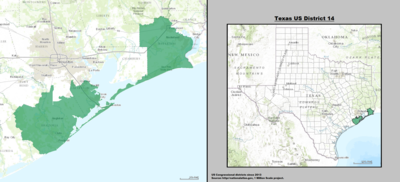Texas' 14th congressional district
| Texas's 14th congressional district | |
|---|---|

Texas's 14th congressional district - since January 3, 2013.
|
|
| Current Representative | Randy Weber (R–Pearland) |
| Distribution |
|
| Population (2015) | 739,877 |
| Median income | 50,178 |
| Ethnicity |
|
| Cook PVI | R+12 |
Texas's 14th district for the United States House of Representatives is a Congressional district that from covered the area south and southwest of the Greater Houston region, including Galveston, in the state of Texas. The district now stretches from Freeport to Beaumont.
The district was created as a result of the 1900 U.S. Census and was first contested in 1902. The Galveston area had previously been included in Texas' 10th congressional district. Its first representative was the Democrat James L. Slayden, based in San Antonio, who had served the 12th congressional district since 1897 and was redistricted. He was elected from the new district and began representing the 14th in March 1903 as a member of the 58th United States Congress. He was repeatedly re-elected and served until 1919. He refused nomination in 1918.
Republican Harry M. Wurzbach carried this district in several elections, from 1920 to 1926, serving from 1921 to 1929. He successfully contested the election of 1928, taking his seat in 1930 for the remainder of the term, and was re-elected in 1930. The district included Guadalupe County, whose German Americans had historically opposed slavery and supported the Republican Party well into the 20th century. In addition, Galveston was a major port of entry for immigrants, with many arriving from southern and eastern Europe. At that time, many found the Republican Party more welcoming than the dominant Democratic Party. In 1901, the Democratic-dominated legislature had passed a poll tax, which effectively had disfranchised most blacks and many poor whites and Latinos.
...
Wikipedia
